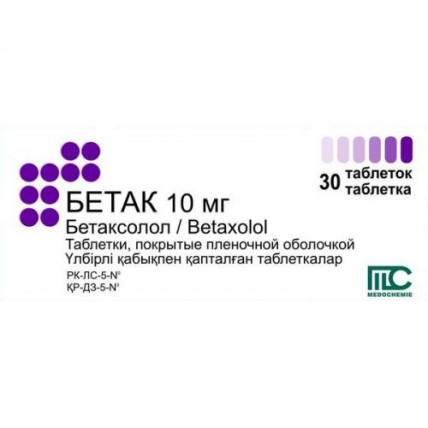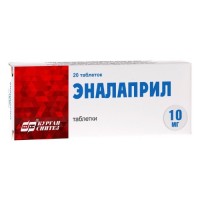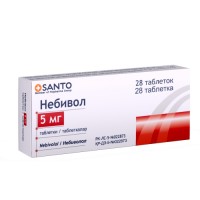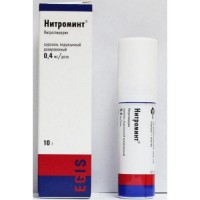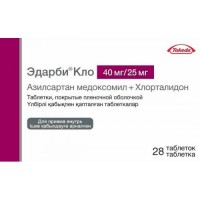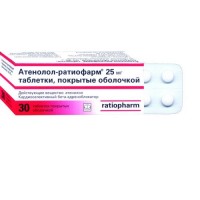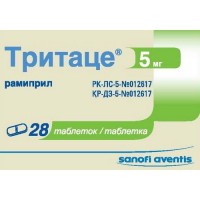Betaki 30s 10 mg film-coated tablets
- $19.30
The instruction for medical use of Betak Torgovoye medicine a name Betak Mezhdunarodnoye the unlicensed name Betaksolol Lekarstvennaya the Tablet form, film coated, 10 mg Structure One tablet contains active agent - a betaksolol a hydrochloride of 10.00 mg excipients: microcrystalline cellulose, lactoses monohydrate, starch sodium glycollate, silicon dioxide colloidal anhydrous, magnesium stearate Film covering of Opadri white YO-B-28920: polyvinyl alcohol, the titan E171 dioxide, talc purified, lecithin, xanthane gum, the water purified. The description of the Tablet of round shape, with a convex surface, film coated white color, with a diameter of kernel of 7 mm. Pharmacotherapeutic group Beta blockers. Selection beta blockers. Betaksolol. The ATX C07AB05 code the Pharmacological Pharmacokinetics Later properties of oral administration drug is quickly soaked up from digestive tract. The absolute bioavailability is 90%. Effect of drug begins in 1-2 h after reception, duration of action of 24 h. The maximum concentration (Cmax) is reached in 2-4 h. The antihypertensive effect occurs in 2-5 days. Balance in plasma is reached in 5-7 days, when prescribing drug according to the scheme once a day. Drug communicates from a plasma belkema for 50%. The volume of distribution is from 4.9 l/kg up to 9.8 l/kg. Slightly gets through hematoencephalic and placentary barriers, in a small amount it is allocated with breast milk. Elimination half-life (Т½) makes 14-22 h. About 80% of the accepted dose are removed with urine, 15% are removed in an invariable look, the rest - in the form of inactive metabolites. In abnormal liver function Т½ it is extended for 33%, in a renal failure approximately for 50%. Therefore the dose decline is required. A pharmacodynamics Cardioselective β1-адреноблокатор without internal sympathomimetic activity. Has hypotensive, antiarrhytmic and anti-anginal effect, possesses insignificant membrane stabilizing action. Blocks heart beta1-adrenoceptors, reduces stimulated catecholamines formation of tsAMF from ATP and intracellular current of Sa2+. Urezhayet heart rate, oppresses conductivity and excitability, reduces contractility of a myocardium. The hypotensive effect is connected with reduction of minute volume of a blood-groove, sympathetic stimulation of peripheral vessels, decrease of the activity renin-angiotenzinovoy of a system, sensitivity of baroreceptors of an aortic arch. The anti-anginal effect is caused by reduction of need of a myocardium for oxygen as a result of an urezheniye of heart rate and decrease in contractility, lengthening of a diastole, improvement of perfusion of a myocardium. Due to increase in end diastolic pressure in a left ventricle and increases in stretching of muscle fibers of ventricles can increase oxygen requirement, especially at patients with chronic heart failure. The antiarrhytmic effect is caused by elimination of aritmogenny factors (tachycardias, superactivity of sympathetic nervous system, the increased maintenance of tsAMF, arterial hypertension), reduction of speed of excitement of sinus and ectopic pacemakers and delay of atrioventricular carrying out. Indications - arterial hypertension - prevention of attacks of stable angina of exertion the Route of administration and doses of the Tablet for intake. Accept once a day, irrespective of meal. Arterial hypertension: at easy degree of arterial hypertension the initial dose makes 10 mg of 1 times a day. If necessary, in 7-14 days it is possible to increase a dose to 20 mg. In moderate hypertensia a standard dosage of 20 mg of 1 times a day. The dose exceeding 20 mg does not enhance antihypertensive effect though it is transferred well. Prevention of attacks of stable angina of exertion: a standard dosage of 20 mg a day. In certain cases, depending on clinical effect, increase in a dosage up to 40 mg is possible. At elderly patients: the initial dose makes 5 mg. At patients with a renal failure, at clearance of creatinine more than 20 ml/min., dose adjustment are not required, however clinical observation within 1 week from an initiation of treatment is recommended. At patients with clearance of creatinine less 20ml/mines and the patients who are on a hemodialysis or peritoneal dialysis, the initial dose makes 5 mg of 1 times a day (regardless of frequency and time of dialysis). If necessary, every 7-14 days the dose is increased by 5 mg, as much as possible to 20 mg. In a liver failure the dose adjustment is not required, but observation in a hospital in an initiation of treatment is recommended. The hypotensive effect occurs in 2-5 days of use, stable action is noted in 1-2 months. To carry out cancellation of treatment gradually, within 2 weeks, under control of the doctor. During this period the monitoring of patients is recommended. Side effects the Frequency of emergence of side reactions is defined according to MedDRA frequency: Very often (≥1/10), it is frequent (≥1/100, & lt, 1/10), infrequently (≥1/1000, & lt, 1/100), is rare (≥1/10.000, & lt, 1/1.000), is very rare (& lt, 1/10.000) it is frequent: an asthenia, insomnia, dizziness, a headache, bradycardia (including acute form of bradycardia), a cold snap of extremities, a gastralgia, nausea, vomiting, diarrhea, impotence. Seldom: a depression, heart failure, a lowering of arterial pressure or delay of atrioventricular (AV) conductivity or strengthening the existing blockade AV, Reynaud's syndrome, strengthening of symptoms of a syndrome of Sharko, a bronchospasm, various types of skin reaction, including developing of psoriasis or strengthening of degree of existing. Very seldom: hypoglycemia, hyperglycemia, hallucinations, confusion of consciousness, nightmares, distal paresthesia, decrease in visual acuity. Emergence of antinuclear antibodies which were followed by clinical symptoms like a system erythematic lupus and disappeared after treatment interruption was in rare instances noted. The contraindication - hypersensitivity to drug, or other beta blockers - atrioventricular block ΙΙ-ΙΙΙ degrees - chronic heart failure in a decompensation stage (fluid lungs, a hypoperfusion syndrome, hypotension) - the continuing or periodic inotropic therapy directed to stimulation of beta adrenoceptors - clinically significant sinus bradycardia (heart rate less than 40/mines) - not treated pheochromocytoma - cardiogenic shock or heart failure - Printsmetal's stenocardia - a cardiomegaly (without symptoms of heart failure) - a metabolic acidosis - bronchial asthma (severe form), chronic obstructive pulmonary diseases - a concomitant use of inhibitors of a monoaminooxidase (MAO) - a sick sinus syndrome - the significant disturbances of peripheric circulation, Reynaud's syndrome - hypotension - an acute anaphylaxis in the anamnesis - the lactation period - a congenital lactose intolerance, hereditary intolerance of fructose, glyukozo-galaktozny malabsorption - use of a betaksolol in a combination with floktafeniny or sultopridy is not recommended in/in introduction of blockers of calcium channels (for example, verapamil or diltiazem) and other antiarrhytmic drugs (Amiodaronum or Disopyramidum, etc.) to the patients receiving betaksolol. Medicinal interactions Contraindicated combinations: betaksolol and floktafenin - in case of shock or hypotension caused floktafeniny the beta-blockers reduce cardiovascular compensatory reactions, betaksolol and sultoprid – strengthening of effect of a betaksolol and sultoprid, development of the profound bradycardia is possible. Use of a betaksolol with inhalation galogensoderzhashchy anesthetics leads to decrease in cardiovascular compensatory reactions. (the beta and adrenergic inhibition can be eliminated by reception beta mimeticheskikh drugs). Gradual cancellation of beta-blockers and informing the anesthesiologist on administration of drugs is recommended. The allergens used for an immunotherapy or extracts of allergens for conducting skin tests increase risk of emergence of heavy system allergic reactions or an anaphylaxis at the patients receiving betaksolol. Iodinated X-ray contrast means for in/in introductions increase risk of development of anaphylactic reactions, reduce compensatory cardiovascular reactions. Phenytoinum at in in introduction, medicines for inhalation anesthesia (derivatives of hydrocarbons) increase expressiveness of cardiodepressive action and probability of a lowering of arterial pressure. Betaksolol changes efficiency of insulin and oral hypoglycemic medicines, masks symptoms of the developing hypoglycemia. Reduces clearance of lidocaine, xanthines (except Diphyllinum) and increases their concentration in blood plasma, especially at patients with initially increased clearance of theophylline under the influence of smoking. The hypotensive effect of a betaksolol is weakened by nonsteroid protivospalitelny means, sympathomimetics, glucocorticosteroids and estrogen. Cardiac glycosides, Methyldopum, reserpine and guanfatsin, blockers of calcium channels (verapamil, diltiazem), Amiodaronum and other antiarrhytmic drugs increase risk of emergence or aggravation of bradycardia, atrioventricular block, cardiac arrest and heart failure. Nifedipine can lead to a considerable lowering of arterial pressure. Diuretics, a clonidine, sympatholytics, gidralazin and other hypotensive drugs can lead to a considerable lowering of arterial pressure. Betaksolol extends action of muscle relaxants and anticoagulating effect of coumarins. Rub - and tetracyclic antidepressants, antipsychotic drugs (neuroleptics), ethanol, sedative and somnolent medicines strengthen oppression of the central nervous system. Simultaneous use with MAO inhibitors owing to considerable strengthening of hypotensive action is not recommended, having rummaged in treatment between intake of MAO inhibitors and betaksololy has to make not less than 14 days. Baclofenum enhances hypotensive effect of a betaksolol. Meflokhin increases risk of developing of bradycardia (the additive effect including bradycardia). Combined use of a betaksolol with not hydrogenated alkaloids of an ergot increases risk of development of disturbances of peripheric circulation. Special instructions should not be interrupted treatment, especially to patients with an ischemic heart disease, without preliminary consultation with the doctor since sudden cancellation can lead to heavy disturbances of a warm rhythm, a myocardial infarction or cardiac arrest. The dose should be reduced gradually (by 5 mg each 3-4 days) within 1-2 weeks. In case of need, it is possible to begin at the same time replacement therapy with other anti-anginal means to avoid increase of attacks of stenocardia. At patients with bronchial asthma and a chronic obstructive pulmonary disease Betak appoint only at moderate severity of a disease, in a low initial dose. Before an initiation of treatment it is recommended to carry out the breath function assessment. At development of attacks during treatment, bronchodilators - beta2-adrenomimetik can be used. With care it is necessary to use drug at a pheochromocytoma, control of arterial blood pressure is required. At patients with the heart failure controlled therapeutic Betak apply under strict medical observation, in very low initial doses with their gradual increase if necessary, and in case of good tolerance (preservation of the compensated condition of chronic heart failure). If at the patient of ChSS at rest makes less than 50-55 blows/min. it is necessary to lower a drug dosage. Considering negative dromotropic effect, at blockade of the I degree drug should be used with care. In a renal failure the dose adjustment taking into account clearance of creatinine is necessary. When prescribing the drug Betak to patients with psoriasis careful assessment of need of its use since demands. beta-blockers can cause aggravation of symptoms. Beta blockers reduce intraocular pressure that can affect results of screening of glaucoma therefore it is necessary to inform the ophthalmologist on administration of drug Betak. When carrying out the general anesthesia it is necessary to consider risk of emergence of blockade of β-adrenoceptors (reduction of ChSS, decrease in warm emission, decrease in systolic and diastolic arterial blood pressure). Beta blockers mask reflex tachycardia and increase risk of developing arterial hypotension. Therapy continuation by beta blockers reduces risk of developing arrhythmia, ischemia of a myocardium and hypertensive crises. It is necessary to inform the anesthesiologist on administration of drug Betak. In case of need the terminations of therapy before surgical intervention, it it is necessary to make gradually and to finish for 48 h before carrying out the general anesthesia since the termination of therapy on 48 h allows to restore sensitivity of receptors. In certain cases therapy by beta blockers can not be interrupted: — at patients with coronary insufficiency it is desirable to continue treatment up to surgical intervention, considering the risk connected with sudden cancellation of beta blockers — in case of the emergency surgical interventions or cases when the termination of treatment is impossible it is necessary to appoint an adequate dose of atropine, with repetition as required, for prevention of parasympathetic reaction, it is necessary to apply the substances which are least oppressing a myocardium to the general anesthesia. Risk of development of anaphylactic reactions has to be considered. Betak can mask initial symptoms of a hypoglycemia (tachycardia, heart consciousness, perspiration) therefore at use for patients with diabetes, regular control of level of glucose in blood is necessary. Thyrotoxicosis symptoms can also mask at therapy by Betak. At therapy by the drug Betak positive reaction when conducting anti-doping test is possible. Use in pediatrics is not recommended use of drug for children up to 18 years. Use during pregnancy and a lactation the Beta-blockers are capable to reduce placentary blood circulation that can lead to pre-natal death, the birth of a dead fruit, an abortion or premature births. Also the fruit can have side reactions (in particular a hypoglycemia and bradycardia). Use of a betaksolol at pregnancy is possible only in case of emergency after assessment advantage/risk. If mother received treatment by beta-blockers during pregnancy which are capable to influence the newborn within several days after the birth, there is a risk of emergence of warm and pulmonary complications during the post-natal period. In case of developing of heart failure at the newborn, hospitalization in intensive care unit is necessary. Use of plasma substitutes is not recommended (because of risk of developing of an acute fluid lungs). Also cases of bradycardia, respiratory insufficiency, a hypoglycemia were noted. During the first 3-5 days the careful observation of the newborn in specialized department after the delivery is necessary (a warm rhythm, glucose level in blood). Betaksolol is allocated in breast milk therefore at administration of drug the breastfeeding is not recommended. Influence on ability to driving of motor transport and to control of other potentially dangerous mechanisms. Considering side effects of drug, it is necessary to be careful when driving or other potentially dangerous mechanisms requiring special attention and speed of psychomotor reactions. Overdose Symptoms: bradycardia, atrioventricular block, lowering of arterial pressure, faint, heart failure, bronchospasm, spasms. Treatment: symptomatic and supporting. In arterial hypotension if there are no symptoms of a fluid lungs, it is recommended in/in drop infusion of plasma substitutes, at inefficiency – adrenaline, a dopamine, Dobutaminum. For elimination of bradycardia appoint atropine. In case of an acute heart failure the therapy is immediately supplemented with digitalis drugs, diuretics, oxygen. The bronchospasm eliminates β2 – agonists. Additional therapy by Aminophyllinum is possible. At atrioventricular block it is shown in/in administration of atropine, the alupent or
a drenalin, a temporary pacemaker, in spasms diazepam. There is no specific antidote. The form of release and packing On 10 tablets place in blister strip packaging from a film of polyvinylchloride and aluminum foil. On the 3rd planimetric packing together with the instruction for medical use in the state and Russian languages place in a pack. Storage conditions In the dry, protected from light place, at a temperature not over 25 of 0C. To store out of children's reach! A period of storage 3 years not to use drug after expiry date. Prescription status According to the prescription Medokemi Ltd Producer, CYPRUS Constantinoupoleos Street, 3011, Limassol, Cyprus Phone: 0035725867600 Fax: 0035725560863 Holder of the registration certificate of Medokemi Ltd, CYPRUS Constantinoupoleos Street, 3011, Limassol, Cyprus Phone: 0035725867600 Fax: Representative office of Medokemi LTD in Republic of Kazakhstan 050008 Almaty, Mukanov St. 241, office 1 of "B"
to Develop 0035725560863 Address of the organization of the claim accepting in the territory of the Republic of Kazakhstan for quality of products (goods) from consumers
a drenalin, a temporary pacemaker, in spasms diazepam. There is no specific antidote. The form of release and packing On 10 tablets place in blister strip packaging from a film of polyvinylchloride and aluminum foil. On the 3rd planimetric packing together with the instruction for medical use in the state and Russian languages place in a pack. Storage conditions In the dry, protected from light place, at a temperature not over 25 of 0C. To store out of children's reach! A period of storage 3 years not to use drug after expiry date. Prescription status According to the prescription Medokemi Ltd Producer, CYPRUS Constantinoupoleos Street, 3011, Limassol, Cyprus Phone: 0035725867600 Fax: 0035725560863 Holder of the registration certificate of Medokemi Ltd, CYPRUS Constantinoupoleos Street, 3011, Limassol, Cyprus Phone: 0035725867600 Fax: Representative office of Medokemi LTD in Republic of Kazakhstan 050008 Almaty, Mukanov St. 241, office 1 of "B"
to Develop 0035725560863 Address of the organization of the claim accepting in the territory of the Republic of Kazakhstan for quality of products (goods) from consumers
